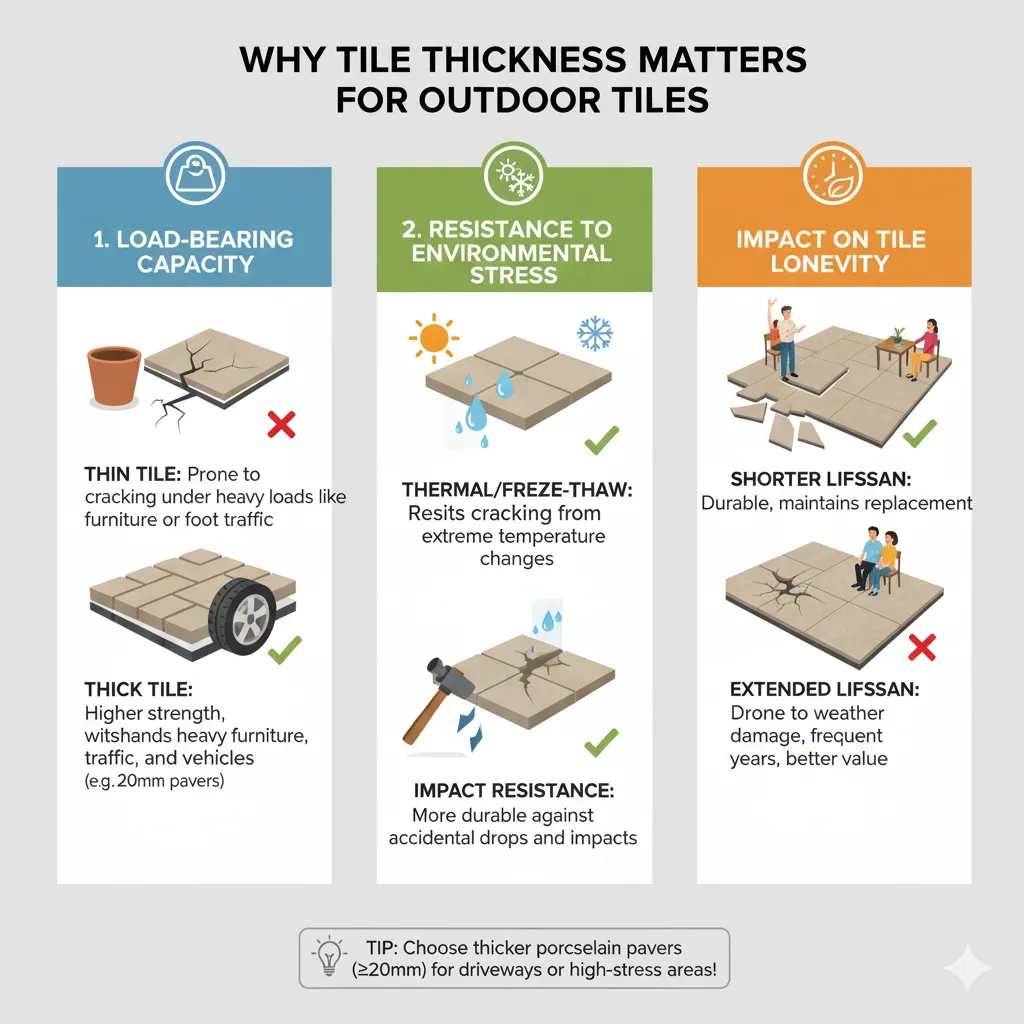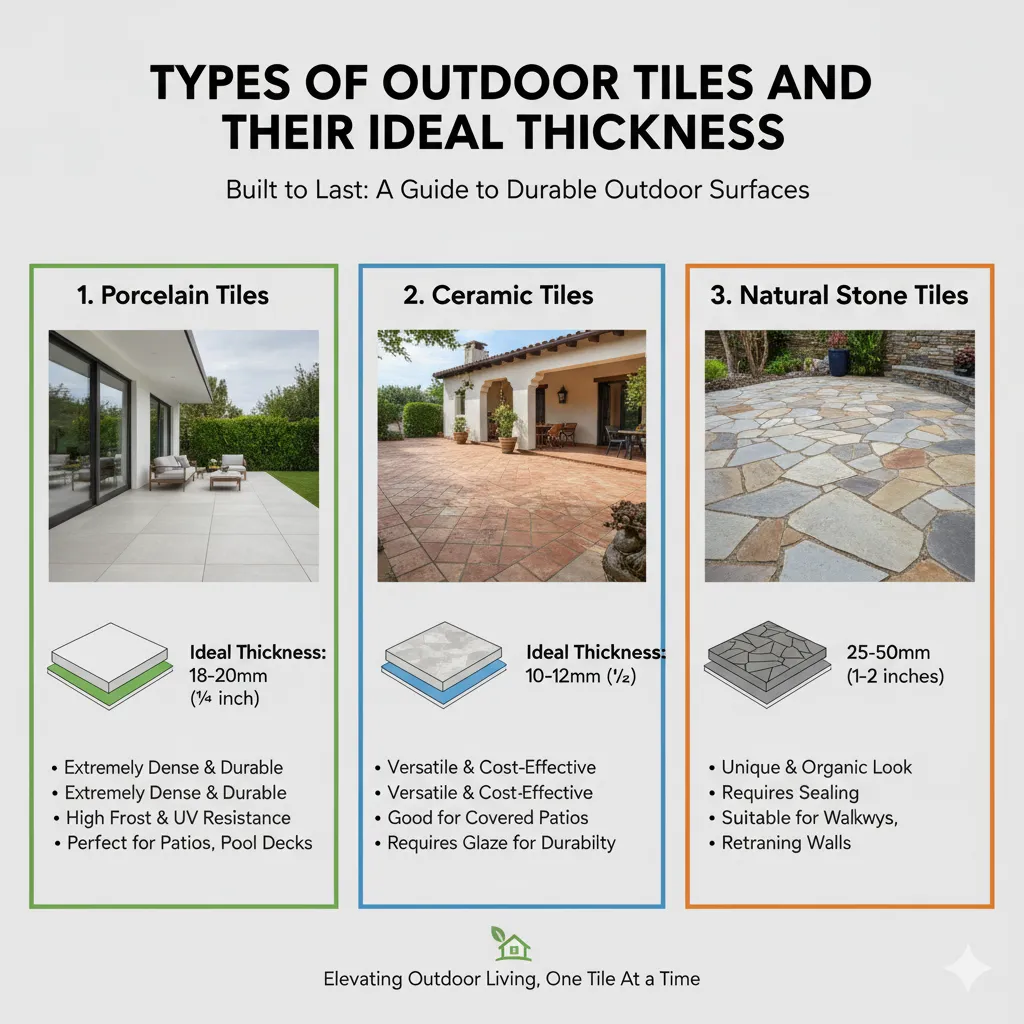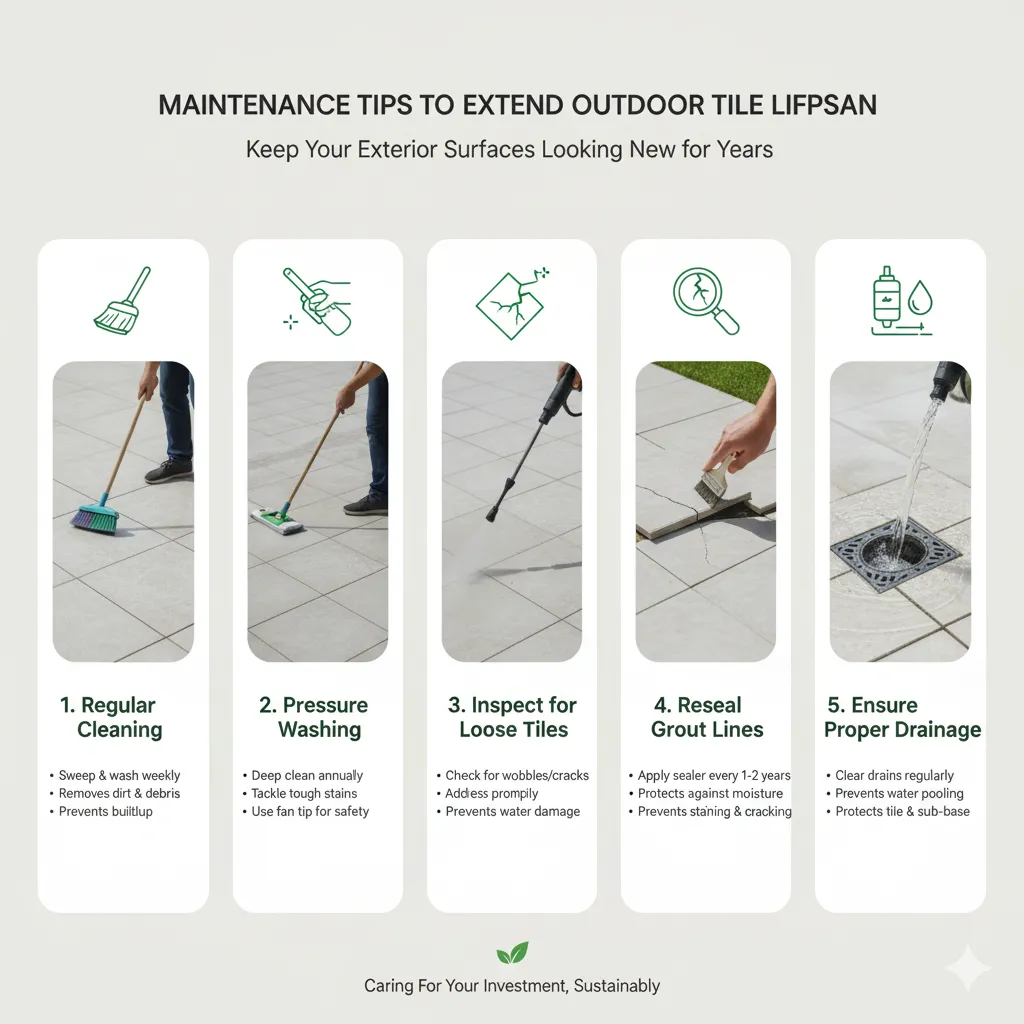
HDPE Monofilament vs Polypropylene Rope: Which Is Better?
05 November, 2025
Connect With Our Team
Outdoor spaces like patios, rooftop decks, walkways, and terraces are essential extensions of our homes and commercial spaces. They offer a perfect blend of aesthetics and functionality. One of the most critical elements that determine the longevity and durability of outdoor areas is tile selection specifically tile thickness. Not all outdoor tiles are created equal; differences in quality, durability, and suitability mean that choosing the right material is essential for outdoor use. Understanding how tile thickness affects outdoor tile lifespan is crucial for homeowners, architects, and designers aiming to create durable, low-maintenance, and visually appealing surfaces.
In this article, we will explore the impact of tile thickness, tile type, installation methods, and environmental factors on outdoor tiles, helping you make informed decisions when designing outdoor spaces.
Outdoor tiles are an essential component of any exterior space, offering both durability and visual appeal for a wide range of applications. Whether you’re designing a patio, walkway, or rooftop deck, choosing the right outdoor tiles is crucial for creating a surface that can handle the demands of daily life. Porcelain tiles are especially popular for outdoor use, thanks to their incredibly resilient nature and ability to withstand heavy foot traffic and harsh weather exposure.
Slip resistance is another key factor, ensuring safety in wet or high-traffic areas. With proper installation and regular maintenance, outdoor tiles can considerably increase the lifespan and functionality of your outdoor space, making them a smart investment for both homeowners and commercial spaces seeking long-lasting, attractive surfaces.
Tile thickness refers to the vertical measurement of a tile from its top surface to the bottom. For outdoor tiles, thickness varies based on the material and intended application. Common tile thickness ranges include:
Porcelain tiles: 8–20 mm for outdoor applications
Ceramic tiles: 8–12 mm for lighter foot traffic areas
Natural stone tiles: 10–30 mm depending on density and finish
The thickness of a ceramic tile is especially important, as it directly impacts the tile’s strength, durability, and suitability for different applications compared to other tile types. Thicker tiles tend to be more robust, providing durable tiles capable of withstanding heavy foot traffic, thermal expansion, and freeze-thaw cycles in colder climates. However, thickness alone is not the only factor; proper substrate preparation, installation methods, and environmental conditions also play a significant role in determining tile longevity.
The composition of outdoor tiles is a major factor in determining their performance and longevity. Ceramic tiles are crafted from natural clay and minerals, then fired at extremely high temperatures to create a hard, durable surface suitable for many outdoor applications. Porcelain tiles, a specialized type of ceramic, are made from finer, denser clay and fired at even higher temperatures, resulting in a tile that is less porous and more resistant to moisture and heat fluctuations.
This makes porcelain tiles particularly well-suited for outdoor use, as they can better withstand the challenges posed by the elements. Understanding the differences in tile composition helps you select the most appropriate tiles for your specific outdoor environment, ensuring lasting beauty and durability.

Outdoor tiles are exposed to high traffic areas, including residential walkways and commercial outdoor spaces. Thicker tiles have greater structural integrity, which reduces the risk of cracking, edge chipping, and uneven tiles caused by stress. For instance:
8–10 mm tiles are suitable for light residential use, such as balconies or small patios.
12–20 mm tiles are ideal for rooftop decks, driveways, or commercial spaces with frequent foot traffic.
By choosing the right thickness, you minimize costly repairs and extend the service life of your outdoor surfaces.
Outdoor tiles face environmental stress such as:
Freeze-thaw cycles in colder climates
Prolonged sun exposure causing thermal expansion
Rainwater penetration and moisture infiltration
Thicker porcelain tiles or natural stone tiles are more resilient against these conditions. Tiles with adequate thickness resist cracking and maintain tile surface integrity over time.
Tile longevity is directly influenced by material composition, thickness, and installation quality. Thicker tiles provide better durability against:
Scratches from loose debris or heavy furniture
Surface etching on delicate materials like natural stone
Structural stress from uneven substrates
While ceramic tiles are suitable for residential applications, porcelain tiles with higher thickness are often recommended for outdoor spaces prone to heavy use and harsh weather.

Different tile types require specific thickness to ensure durability and safety outdoors. Porcelain tile is especially suitable for outdoor applications due to its exceptional durability, resilience against weather and UV exposure, and versatile aesthetic options.
Outdoor porcelain tiles are highly durable due to low water absorption and high density. Thickness recommendations:
8–12 mm: Residential patios and balconies
12–20 mm: Commercial spaces, heavy foot traffic, and rooftop decks
Porcelain is frost resistant and maintains slip resistance, making it ideal for wet areas like pool decks. Thicker tiles also withstand thermal expansion and prolonged exposure to extremely high temperatures.
Outdoor ceramic tiles are lighter and less dense than porcelain. Recommended thickness:
8–12 mm for light residential use
Avoid using thin ceramic tiles in areas exposed to freeze-thaw cycles
Ceramic tiles are less resistant to edge chipping and cracking, making proper installation and substrate preparation critical for outdoor use.
Natural stone tiles like granite, slate, and travertine require thickness ranging from 10–30 mm, depending on density. These tiles are ideal for outdoor terraces and walkways due to their natural durability. Considerations include:
Etch natural stone using pH neutral cleaners
Apply Long-lasting grout sealer to protect from moisture infiltration
Ensure proper grout lines to allow for expansion and contraction
Thicker stone tiles maintain stability and resist scratching delicate surfaces issues over time.
Outdoor tiles are versatile and can be used in a variety of settings, from patios and walkways to rooftop decks. However, in regions that experience freeze-thaw cycles, it’s essential to choose tiles that are specifically designed to handle these challenging conditions. Porcelain tiles are an excellent option for colder climates, as their dense, frost-resistant composition helps prevent cracking and damage caused by freezing and thawing.
Proper substrate preparation is equally important ensuring a stable base and effective drainage system helps prevent water from seeping into grout lines, which can lead to costly damage when temperatures drop. By selecting frost-resistant tiles and following best practices for installation, you can protect your outdoor surfaces and enjoy long-lasting performance, even in the harshest weather.
Even the right tile thickness cannot guarantee longevity without proper installation. Essential factors include:
A well-prepared substrate is essential to prevent uneven tiles. Ensure proper slope, drainage, and smooth surface to support thicker tiles. Using quality adhesives suited for outdoor use is equally important.
Adhesive selection should match tile type and thickness
Grout lines must accommodate thermal expansion and prevent water penetration
Applying penetrating grout sealer considerably increase tile lifespan
Outdoor tiles experience thermal expansion, especially in extremely high temperatures. Proper installation with expansion joints prevents cracks.
Areas with heavy foot traffic require thicker and denser tiles
Residential patios may use standard thickness, but commercial areas need exceptionally durable tiles
Outdoor tiles must endure frost damage cycles, extremely high temperatures, and rapid temperature changes. Thicker tiles tend to absorb stress better, preventing cracks and maintaining surface integrity.
Water infiltration can weaken tiles over time. Using low water absorption materials like porcelain and applying Long-lasting grout sealer protects against moisture-related damage.
Sunlight can cause discoloration and fading. Thick porcelain tiles and natural stones maintain their aesthetics longer under prolonged sun exposure.
Use pH neutral cleaners to avoid etching delicate surfaces. For routine cleaning of outdoor tiles, a ph neutral cleaner is the best choice to preserve their finish and integrity.
Avoid harsh chemicals that penetrate grout lines and damage tiles

Even the right thickness and material need proper care. Key maintenance steps include:
Regular Cleaning: Remove loose debris and dirt using a soft brush
Pressure Washing: Suitable for durable tiles, but avoid delicate surfaces
Inspect for Loose Tiles: Repair or replace tiles showing early signs of cracking
Reseal Grout Lines: Prevent moisture infiltration and protect tile surface
Ensure Proper Drainage: Avoid water pooling on outdoor spaces
Following these steps can significantly extend the life of outdoor tiles, especially in areas with harsh weather conditions.
Using thin tiles in high-traffic areas
Ignoring substrate preparation and proper installation
Overlooking expansion joints for thermal movement
Using harsh chemicals on natural stone tiles
Ignoring proper drainage, leading to moisture infiltration
Avoiding these mistakes ensures your outdoor tiles remain functional and visually appealing for years.
Selecting the right outdoor tiles involves more than just picking a style you like it requires a curated selection that addresses the unique needs of your project. Key considerations include tile thickness, durability, and slip resistance. Heavier tiles usually offer greater strength and are less likely to crack under pressure, making them ideal for high-traffic or commercial spaces. Tiles with a textured surface enhance slip resistance, providing added safety in wet or exposed areas.
By choosing the right tile for your outdoor space and ensuring proper installation, you can create a beautiful, functional area that stands up to the elements. Regular cleaning and maintenance further extend the life of your tiles, ensuring your investment continues to add value and appeal to your property for years to come.
Selecting the right tile thickness requires consideration of:
Tile type (porcelain, ceramic, natural stone)
Expected foot traffic (residential vs. commercial)
Local climate conditions
Substrate and installation quality
Maintenance capabilities
Thicker tiles are not always necessary for residential patios, but in areas with high traffic, harsh weather, or heavy furniture, investing in thicker, denser tiles pays off in tile durability and fewer costly repairs.
Get Quality Outdoor Tiles Here!
Tile thickness is an essential factor that affects outdoor tile lifespan. Thicker tiles are more resistant to environmental stress, freeze-thaw cycles, and heavy foot traffic. Coupled with the right material, proper installation, and maintenance, you can ensure your outdoor tiles remain durable and beautiful for years.
By paying attention to these essential insights, you can select the right tile thickness for any residential or commercial space, avoiding costly repairs and maximizing tile durability.
By understanding how Outdoor tile lifespan depends on thickness, you can make informed decisions that enhance both the durability and aesthetics of your outdoor spaces. Investing in the right thicker tiles, quality installation, and regular care ensures that your patios, walkways, and terraces remain beautiful and functional for years to come.
At Grepl Group, we understand the importance of combining the right thickness with superior quality materials to deliver outdoor tiles that stand the test of time. By selecting tiles engineered for strength and longevity, you not only enhance the beauty of your outdoor spaces but also make a smart investment in durability and performance.
Yes, wall tiles are generally thinner than floor tiles, but for outdoor vertical surfaces exposed to weather, slightly thicker tiles with proper installation are recommended to ensure durability and prevent cracking.
Other vertical surfaces include garden walls, pillars, and balcony facades. Using the right tile thickness and slip-resistant materials helps ensure safety and long-lasting performance.
Considering your outdoor vision like color, texture, and pattern helps you select the right thickness and type of tile that complements your outside spaces while maintaining durability.
Incorrect installation can lead to moisture infiltration, edge chipping, and costly repairs. Following proper installation guidelines and using the right adhesive is key.
Absolutely. Selecting the right tile type porcelain, ceramic, or natural stone with appropriate thickness and slip resistance ensures longer tile lifespan and reduces maintenance.
A curated selection ensures you choose tiles with suitable thickness, slip resistance, frost resistance, and durability for high-traffic or exposed outdoor spaces, optimizing both aesthetics and longevity.
Yes, slip-resistant tiles reduce the risk of accidents in wet conditions and are highly recommended for rooftops, decks, pool surrounds, and other outdoor spaces.
Outdoor porcelain tiles are dense, low-porosity, and highly durable. Using the correct thickness ensures they withstand frost damage cycles, heavy foot traffic, and natural stress.

Whatsapp Chatx
Hi! Click one of our representatives below to chat on WhatsApp or send us email to exports@greplgroup.com
 |
Mr. Milanbhai +91 96871 06588 |
 |
Mr. Hirenbhai +91 95373 06588 |